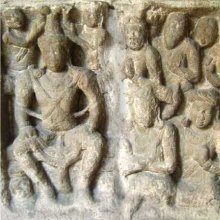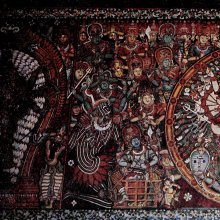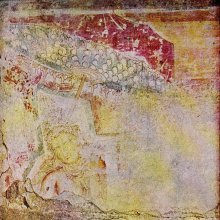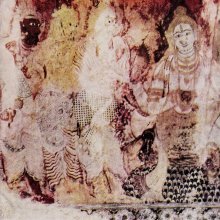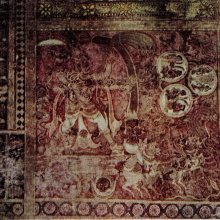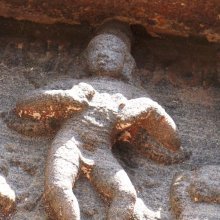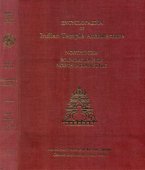Pallava, Pallavā, Pāllavā: 43 definitions
Introduction:
Pallava means something in Buddhism, Pali, Hinduism, Sanskrit, the history of ancient India, Marathi, Jainism, Prakrit, Hindi. If you want to know the exact meaning, history, etymology or English translation of this term then check out the descriptions on this page. Add your comment or reference to a book if you want to contribute to this summary article.
Images (photo gallery)
(+9 more images available)
In Hinduism
Natyashastra (theatrics and dramaturgy)
Source: Wisdom Library: Nāṭya-śāstraPallava (पल्लव) refers to a gesture (āṅgika) made with ‘dance hands’ (nṛttahasta), according to the Nāṭyaśāstra chapter 8. The hands (hasta) form a part of the human body which represents one of the six major limbs (aṅga) used in dramatic performance. With these limbs are made the various gestures (āṅgika), which form a part of the histrionic representation (abhinaya).
Source: archive.org: The mirror of gesture (abhinaya-darpana)Pallava is one of the saṃyutta-hastāni (Twenty-seven combined Hands).
Source: archive.org: Natya ShastraPallava (पल्लव).—A type of gesture (āṅgika) made with dance-hands (nṛttahasta);—(Instructions): The two Patāka hands joined at the wrist. The Dance-hands are to be used in forming Karaṇas.

Natyashastra (नाट्यशास्त्र, nāṭyaśāstra) refers to both the ancient Indian tradition (shastra) of performing arts, (natya—theatrics, drama, dance, music), as well as the name of a Sanskrit work dealing with these subjects. It also teaches the rules for composing Dramatic plays (nataka), construction and performance of Theater, and Poetic works (kavya).
Purana and Itihasa (epic history)
Source: Wisdom Library: Varāha-purāṇaPallavā (पल्लवा).—Name of a river (nadī) situated near the seven great mountains on the western side of mount Naiṣadha, according to the Varāhapurāṇa chapter 83. These settlements consume the water flowing from these seven great mountains (Viśākha, Kambala, Jayanta, Kṛṣṇa, Harita, Aśoka and Vardhamāna). Niṣadha (Naiṣadha) is one of the seven mountains located in Jambūdvīpa, ruled over by Āgnīdhra, a grandson of Svāyambhuva Manu, who was created by Brahmā, who was in turn created by Nārāyaṇa, the unknowable all-pervasive primordial being.
Source: archive.org: Shiva Purana - English TranslationPallava (पल्लव) refers to a “leaf” (e.g., of a mango-plant), according to the Śivapurāṇa 2.3.38 (“Description of the dais or maṇḍapa”).—Accordingly, as Himavat prepared the wedding of Menā and Śiva: “Then the lord of mountains, O excellent sage, attended to the decoration of the entire city befitting the great festivities ahead. The roads were watered and swept clean. At every door, stumps of plantain trees and other auspicious symbols were fixed. The courtyard was embellished with plantain trees tied with silken cords. There were festoons of mango leaves (rasāla-pallava). [...]”.
Source: Cologne Digital Sanskrit Dictionaries: The Purana IndexPallava (पल्लव).—A southern tribe.*
- * Matsya-purāṇa 114. 40; Brahmāṇḍa-purāṇa II. 16. 47.
Pallava (पल्लव) is a name mentioned in the Mahābhārata (cf. VI.10.66) and represents one of the many proper names used for people and places. Note: The Mahābhārata (mentioning Pallava) is a Sanskrit epic poem consisting of 100,000 ślokas (metrical verses) and is over 2000 years old.

The Purana (पुराण, purāṇas) refers to Sanskrit literature preserving ancient India’s vast cultural history, including historical legends, religious ceremonies, various arts and sciences. The eighteen mahapuranas total over 400,000 shlokas (metrical couplets) and date to at least several centuries BCE.
Kavya (poetry)
Source: archive.org: Naisadhacarita of SriharsaPallava (पल्लव) refers to 1) a “story” or “narrative”, 2) a “leaf”, and is mentioned in the Naiṣadha-carita 10.83.—In the latter case, the word may very well mean “red lac paint”. Jinarāja says “pāṇiyugmamapi saha pallavena alaktakarāgeṇa vartane”. This meaning is mentioned by Nārāyaṇa also.
Source: Shodhganga: The Kavyamimamsa of RajasekharaPallava (पल्लव) is the name a locality mentioned in Rājaśekhara’s 10th-century Kāvyamīmāṃsā.—This name denotes a dynasty which was ruled over the southern India from the fifth to ninth century A.D. with the capital of Kāñchi. The country surrounding Kāñci very probably was known as the Pallava country after its rulers. Because Rājaśekhara mentioned Kāñchi as a separate country in the southern India.
Source: Brill: Śaivism and the Tantric Traditions (kavya)Pallava (पल्लव) refers to “buds”, according to Bāṇa’s Kādambarī (p. 225-226).—Accordingly, while describing the shire of the Goddess Caṇḍikā, “[Then follows the image of the Goddess Caṇḍikā, which matches the conception of Kālarātri in the passage from the Mahābhārata:] [...] she was adorned in garlands of bilva-leaves furnished with gleaming fruits and buds (phala-pallava-kalita) anointed with red sandalwood, that were like hanging garlands of infant-heads; she expressed cruelty with limbs worshipped with clusters of kadamba flowers ruddy with blood, which horripilated, it seemed, at the thrill of the flavour of the keen roar of drums during the animal-offering; [...]”.

Kavya (काव्य, kavya) refers to Sanskrit poetry, a popular ancient Indian tradition of literature. There have been many Sanskrit poets over the ages, hailing from ancient India and beyond. This topic includes mahakavya, or ‘epic poetry’ and natya, or ‘dramatic poetry’.
Ayurveda (science of life)
Nighantu (Synonyms and Characteristics of Drugs and technical terms)
Source: Wisdom Library: Raj NighantuPallava (पल्लव) refers to a “young leaf” of a tree or plant, as mentioned in a list of four synonyms, according to the second chapter (dharaṇyādi-varga) of the 13th-century Raj Nighantu or Rājanighaṇṭu (an Ayurvedic encyclopedia). The Dharaṇyādi-varga covers the lands, soil, mountains, jungles and vegetation’s relations between trees [viz., Pallava] and plants and substances, with their various kinds.
Toxicology (Study and Treatment of poison)
Source: Shodhganga: Kasyapa Samhita—Text on Visha ChikitsaPallava (पल्लव) refers to the “sprouts (of a particular herb)”, according to the Kāśyapa Saṃhitā: an ancient Sanskrit text from the Pāñcarātra tradition dealing with both Tantra and Viṣacikitsā—an important topic from Āyurveda which deals with the study of Toxicology (Viṣavidyā or Sarpavidyā).—Accordingly, one of the treatments of Karaghna-rat-bites is mentioned as follows: “Paste of Nirguṇḍī sprouts (pallava) must be applied with Mustā, Triphalā and pepper must be eaten with jaggery. Fumigation must be done with Gula and leaves of Asana with sumptuous milk”.
Unclassified Ayurveda definitions
Source: archive.org: Vagbhata’s Ashtanga Hridaya Samhita (first 5 chapters)Pallava (पल्लव) refers to “sprouts”, mentioned in verse 3.34-36 of the Aṣṭāṅgahṛdayasaṃhitā (Sūtrasthāna) by Vāgbhaṭa.—Accordingly, “[...] In groves in which the hot-rayed one is darkened by cloud-grazing huge Sal trees and Palmyra palms, [...] (and which is) covered with the shoots and fruit-pendants of mango-trees; (or) on a couch (which is) prepared from tender banana-leaves, white nymphaeas, lotus-fibres, nelumbos, and blue nymphaeas, (and) in which (are found) opening buds and sprouts [hasatkusuma-pallava]: (there) one shall sleep at noon when pained by the heat of the sun; or in a bath-house”.
Note: Hasatkuswma (“opening bud”) has been replaced by me-tog rgyas-pa (“full-blown flower”) and pallava (“sprout”) left untranslated.
Source: gurumukhi.ru: Ayurveda glossary of termsPallava (पल्लव):—Tender leaves; Synonym of leaf

Āyurveda (आयुर्वेद, ayurveda) is a branch of Indian science dealing with medicine, herbalism, taxology, anatomy, surgery, alchemy and related topics. Traditional practice of Āyurveda in ancient India dates back to at least the first millenium BC. Literature is commonly written in Sanskrit using various poetic metres.
Shilpashastra (iconography)
Source: Shodhganga: The significance of the mūla-beras (śilpa)Pallava (पल्लव) or Pallavahasta refers to “tendril” and represents one of the twenty-four gestures with a single hand, as defined according to texts dealing with śilpa (arts and crafs), known as śilpaśāstras.—Accordingly, pratimā-lakṣaṇa (body postures of the icons) is comprised of hand gestures (hasta, mudrā or kai-amaiti), stances/poses (āsanas) and inflexions of the body (bhaṅgas). There are thirty-two types of hands [viz., pallava-hasta] classified into two major groups known as tolirkai (functional and expressive gestures) and elirkai (graceful posture of the hand).
Source: Shodhganga: Vaisnava Agamas And Visnu ImagesPallava (पल्लव) or Pallavamudrā refers to one of the various hand-poses (hastas or mudrās) defined in treatises such as the Pāñcarātra, Pādmasaṃhitā and Vaikhānasa-āgamas, extensively dealing with the technical features of temple art, iconography and architecture in Vaishnavism.—Pallava-mudrā resemble Ādānahasta in which the palm and finger are slightly bent and the palm faces upward. If the finger are let loose, it appears to be Alapallavamudrā. In the icon of Olayakunnam and of Palani, this [Pallava-mudrā] hand is used to hold the lotus.

Shilpashastra (शिल्पशास्त्र, śilpaśāstra) represents the ancient Indian science (shastra) of creative arts (shilpa) such as sculpture, iconography and painting. Closely related to Vastushastra (architecture), they often share the same literature.
Jyotisha (astronomy and astrology)
Source: Wisdom Library: Brihat Samhita by VarahamihiraPallava (पल्लव) or Pahlava is the name of a kingdom or tribe of people, according to the Bṛhatsaṃhitā (chapter 5), an encyclopedic Sanskrit work written by Varāhamihira mainly focusing on the science of ancient Indian astronomy astronomy (Jyotiṣa).—Accordingly, “If the sun and moon should begin to be eclipsed when only half risen, deceitful men will suffer as well as sacrificial rites. [...] If they should be eclipsed when in the sign of Gemini (Mithuna), chaste women, princes, powerful petty chiefs, learned men, people living on the banks of the Yamunā and the rulers of Bahlikā and Matsya with their subjects will suffer miseries. If they should be eclipsed when in the sign of Cancer (Karka) the Ābhīras, the Śabaras, the Pallavas, the Mallas, the Matsyas, the Kurus, the Śakas, the Pāñcālas and the Vikalās will be afflicted with miseries and food grains will be destroyed”.

Jyotisha (ज्योतिष, jyotiṣa or jyotish) refers to ‘astronomy’ or “Vedic astrology” and represents the fifth of the six Vedangas (additional sciences to be studied along with the Vedas). Jyotisha concerns itself with the study and prediction of the movements of celestial bodies, in order to calculate the auspicious time for rituals and ceremonies.
Shaivism (Shaiva philosophy)
Source: SOAS University of London: Protective Rites in the Netra TantraPallava (पल्लव) refers to “sprouts” (used for paying homage), according to the Netratantroddyota commentary on the Netratantra of Kṣemarāja: a Śaiva text from the 9th century in which Śiva (Bhairava) teaches Pārvatī topics such as metaphysics, cosmology, and soteriology.—Accordingly, [verse 4.4cd]—“[...] People with wealth [should pay homage] with lavish ingredients (mahā-saṃbhāra); for others it may be done even with such meager ingredients as dūrva grass, water, and sprouts (pallava). For in this way there is a supremacy of our teachers [who] lack laziness and [are] free of greed”.

Shaiva (शैव, śaiva) or Shaivism (śaivism) represents a tradition of Hinduism worshiping Shiva as the supreme being. Closely related to Shaktism, Shaiva literature includes a range of scriptures, including Tantras, while the root of this tradition may be traced back to the ancient Vedas.
Shaktism (Shakta philosophy)
Source: Google Books: ManthanabhairavatantramPallava (पल्लव) refers to “tender shoots”, according to the Kularatnoddyota, one of the earliest Kubjikā Tantras.—Accordingly, [while describing the gross form of Navātman called Śabdarāśinavātman]: “(Navātman) has a big body and burns intensely, illumining the sky with (his) radiant energy. [...] He has beautiful hands and feet and thin fingers (like tender) shoots (pallava). [...]”.

Shakta (शाक्त, śākta) or Shaktism (śāktism) represents a tradition of Hinduism where the Goddess (Devi) is revered and worshipped. Shakta literature includes a range of scriptures, including various Agamas and Tantras, although its roots may be traced back to the Vedas.
Sports, Arts and Entertainment (wordly enjoyments)
Source: archive.org: Syainika Sastra of Rudradeva with English Translation (art)Pallava (पल्लव) refers to the “leaf-like (soft hands)” (of women), according to the Śyainika-śāstra: a Sanskrit treatise dealing with the divisions and benefits of Hunting and Hawking, written by Rājā Rudradeva (or Candradeva) in possibly the 13th century.—Accordingly, “Hunting on horseback (āśvina) represents one of the eight subdivisions of Hunting (mṛgayā). [...] The very life and soul of sexual enjeyment are pride, the self-importance, and pleasure. Therefore for one fatigued with hunting are prescribed, the plaster of sandal paste and other things, the shampooing by the leaf-like soft hands (hasta-pallava) of women, syrups, the five elixirs of life, and fanning with palm-leaves. [...]”.

This section covers the skills and profiencies of the Kalas (“performing arts”) and Shastras (“sciences”) involving ancient Indian traditions of sports, games, arts, entertainment, love-making and other means of wordly enjoyments. Traditionally these topics were dealt with in Sanskrit treatises explaing the philosophy and the justification of enjoying the pleasures of the senses.
In Buddhism
Theravada (major branch of Buddhism)
Source: Pali Kanon: Pali Proper NamesA Damila chief, ally of Kulasekhara. Cv.lxxvii.55, 73.
Theravāda is a major branch of Buddhism having the the Pali canon (tipitaka) as their canonical literature, which includes the vinaya-pitaka (monastic rules), the sutta-pitaka (Buddhist sermons) and the abhidhamma-pitaka (philosophy and psychology).
Tibetan Buddhism (Vajrayana or tantric Buddhism)
Source: Brill: Śaivism and the Tantric Traditions (tantric Buddhism)Pallava (पल्लव) refers to “sprouts”, according to the Bhūśalyasūtrapātananimittavidhi section of Jagaddarpaṇa’s Ācāryakriyāsamuccaya, a text within Tantric Buddhism dealing with construction manual for monasteries etc.—Accordingly, “[...] Having praised [the cord] with the sounds of a bell, auspicious song, conch shell, and bamboo flute, the donor should offer guest water [to the cord] together with jewels, gold, and fragrant flowers, which are blooming and beautiful, and mixed with the juice extracted from the sprouts (pallava-uddhṛta) of the airandhrīkara”.

Tibetan Buddhism includes schools such as Nyingma, Kadampa, Kagyu and Gelug. Their primary canon of literature is divided in two broad categories: The Kangyur, which consists of Buddha’s words, and the Tengyur, which includes commentaries from various sources. Esotericism and tantra techniques (vajrayāna) are collected indepently.
India history and geography
Source: Wisdom Library: India HistoryPallava (पल्लव) is the name of a country included within Dakṣiṇapatha which was situated ahead of Māhiṣmatī according to Rājaśekhara (fl. 10th century) in his Kāvyamīmāṃsā (chapter 17). Dakṣiṇāpatha is a place-name ending is patha mentioned in the Gupta inscriptions. The Gupta empire (r. 3rd-century CE), founded by Śrī Gupta, covered much of ancient India and embraced the Dharmic religions such as Hinduism, Buddhism and Jainism.
Source: Early Chola Temples: Sculpture: stoneThe Pallavas should be considered as a power who enriched that tradition by incorporating foreign influences from other equally vital centres of Dravidian art at Amaravati, Nagarjunakonda, Badami and Vengi.
Source: Cologne Digital Sanskrit Dictionaries: Indian Epigraphical GlossaryPallava.—(IE 7-1-2), ‘five’. Note: pallava is defined in the “Indian epigraphical glossary” as it can be found on ancient inscriptions commonly written in Sanskrit, Prakrit or Dravidian languages.
Source: Shodhganga: The significance of the mūla-beras (history)Pallava dynasty.—The Pallavas ruled Kanchi in the 4th century AD and it was during the period of Mahendravarman I (AD 600630), the son of Simha Visnu, that importance was given to the arts. The attitude of the artists towards their task of converting rock into the representation of an event is most obvious in the masterworks of the Pallava period. Being struck by the beauty of the Pallava temples at Kanchi, Vikramaditya I induced some of the sculptors and architects of the Pallava realm to come to his kingdom.
Source: Shodhganga: Elements of Art and Architecture in the Trtiyakhanda of the Visnudharmottarapurana (history)Pallava refers to a certain period in the history of Indian Art.—The chronological order of the development of Indian Art as stated in The Heritage of Indian Art is as follows—[...] 14. The Pallavas of Kanchi belongs to the kingdoms of the Far South and the time of the Pallavas are determined as 600-750 A.D. This period of civilization contains the maṇḍapas and monolithic stone temples at Mahabalipuram and structural temples at Kanchi.

The history of India traces the identification of countries, villages, towns and other regions of India, as well as mythology, zoology, royal dynasties, rulers, tribes, local festivities and traditions and regional languages. Ancient India enjoyed religious freedom and encourages the path of Dharma, a concept common to Buddhism, Hinduism, and Jainism.
Languages of India and abroad
Pali-English dictionary
Source: BuddhaSasana: Concise Pali-English Dictionarypallava : (m.) a young leaf; sprout; name a country.
Source: Sutta: The Pali Text Society's Pali-English DictionaryPallava, (nt.) (cp. Class Sk. pallaka) a sprout J. I, 250; II, 161. See also phallava. (Page 442)

Pali is the language of the Tipiṭaka, which is the sacred canon of Theravāda Buddhism and contains much of the Buddha’s speech. Closeley related to Sanskrit, both languages are used interchangeably between religions.
Marathi-English dictionary
Source: DDSA: The Molesworth Marathi and English Dictionarypallava (पल्लव).—m (S) Sprouting or shooting. v phuṭa, lāga, yē, esp. in pl. 2 The extremity of a branch bearing new leaves; a spring of luxuriant foliage: also a tuft of foliage; a cluster of shoots or sprouts. 3 fig. An addition in narrating a circumstance, an embellishment. 4 An end of a piece of cloth. Ex. pallavīṃ bāndhavēla vāyu kaisā ||. 5 An appendage or additament, a skirt, tail, wing.
Source: DDSA: The Aryabhusan school dictionary, Marathi-Englishpallava (पल्लव).—m Sprouting or shooting. A sprig of luxuriant foliage fig. An embellish- ment. An end of a piece of cloth.
Marathi is an Indo-European language having over 70 million native speakers people in (predominantly) Maharashtra India. Marathi, like many other Indo-Aryan languages, evolved from early forms of Prakrit, which itself is a subset of Sanskrit, one of the most ancient languages of the world.
Sanskrit dictionary
Source: DDSA: The practical Sanskrit-English dictionaryPallava (पल्लव).—1 A sprout, sprig, twig, करपल्लवः (karapallavaḥ); लतेव संनद्धमनोज्ञपल्लवा (lateva saṃnaddhamanojñapallavā) R.3.7; Kumārasambhava 3.54.
2) A bud, blossom.
3) Expansion, spreading, dilating.
4) The red dye called Alakta, q. v. पाणियुग्ममपि सह पल्लवेन अलक्तरागेण वर्तते (pāṇiyugmamapi saha pallavena alaktarāgeṇa vartate); cf. Jinarāja com. on N.1.83.
5) Strength, power.
6) A blade or grass.
7) A bracelet, an armlet.
8) Love, amorous sport.
9) The end of a robe or garment; क्षौममाकुलकरा विचकर्ष क्रान्तपल्लवमभीष्टतमेन (kṣaumamākulakarā vicakarṣa krāntapallavamabhīṣṭatamena) Śiśupālavadha 1.83.
1) Unsteadiness (cāpalam).
11) A story, narrative; सपल्लवं व्यासपराशराभ्यां (sapallavaṃ vyāsaparāśarābhyāṃ)... यद् ववृते पुराणम् (yad vavṛte purāṇam) N.1.83.
-vaḥ A libertine; Viś. Guṇa.425.
Derivable forms: pallavaḥ (पल्लवः), pallavam (पल्लवम्).
--- OR ---
Pāllavā (पाल्लवा).—A game with twigs.
Source: Cologne Digital Sanskrit Dictionaries: Shabda-Sagara Sanskrit-English DictionaryPallava (पल्लव).—mn.
(-vaḥ-vaṃ) 1. A sprout, a shoot, the extremity of a branch bearing new leaves. 2. A branch. 3. Spreading, expansion. 4. A wood. 5. The red dye of lac or Alakta. 6. Love, the sentiment or passion. 7. A catamite. 8. A bracelet. 9. Unsteadiness, moral or physical. E. pad the foot, lū to cut or break, ap aff.
Source: Cologne Digital Sanskrit Dictionaries: Benfey Sanskrit-English DictionaryPallava (पल्लव).—probably for original parṇa + vant, 1. m. and n. A sprout, a shoot, [Śākuntala, (ed. Böhtlingk.)] [distich] 34. 2. m. pl. The name of a people. 3. The red dye of lac; cf. pallavita.
Source: Cologne Digital Sanskrit Dictionaries: Cappeller Sanskrit-English DictionaryPallava (पल्लव).—[masculine] [neuter] sprout, shoot, twig (lit. & [figuratively]); edge of a garment.
Source: Cologne Digital Sanskrit Dictionaries: Monier-Williams Sanskrit-English Dictionary1) Pallava (पल्लव):—1. pallava mn. (ifc. f(ā). ) a sprout, shoot, twig, spray, bud, blossom (met. used for the fingers, toes, lips etc.), [Mahābhārata; Kāvya literature] etc.
2) a strip of cloth, scarf, lappet, [Kādambarī; Bālarāmāyaṇa; Rājataraṅgiṇī]
3) spreading, expansion, [cf. Lexicographers, esp. such as amarasiṃha, halāyudha, hemacandra, etc.] (cf. below)
4) strength, [cf. Lexicographers, esp. such as amarasiṃha, halāyudha, hemacandra, etc.] (= bala; [varia lectio] = vana, a wood)
5) red lac (alakta), [cf. Lexicographers, esp. such as amarasiṃha, halāyudha, hemacandra, etc.]
6) a bracelet, [cf. Lexicographers, esp. such as amarasiṃha, halāyudha, hemacandra, etc.]
7) sexual love, [cf. Lexicographers, esp. such as amarasiṃha, halāyudha, hemacandra, etc.]
8) unsteadiness, [cf. Lexicographers, esp. such as amarasiṃha, halāyudha, hemacandra, etc.]
9) m. a [particular] position of the hands in dancing, [Catalogue(s)]
10) a libertine, catamine, [cf. Lexicographers, esp. such as amarasiṃha, halāyudha, hemacandra, etc.]
11) a species of fish, [cf. Lexicographers, esp. such as amarasiṃha, halāyudha, hemacandra, etc.]
12) [plural] Name of a people, [Mahābhārata; Purāṇa] ([varia lectio] for pahlava)
13) of a race of princes, [Inscriptions]
14) 2. pallava [Nominal verb] [Parasmaipada] vati, to put forth young shoots, [Śatruṃjaya-māhātmya]
15) Pāllavā (पाल्लवा):—f. ([from] pallava, sc. krīḍā) a game played with twigs, [cf. Lexicographers, esp. such as amarasiṃha, halāyudha, hemacandra, etc.]
Source: Cologne Digital Sanskrit Dictionaries: Yates Sanskrit-English DictionaryPallava (पल्लव):—[(vaḥ-vaṃ)] 1. m. n. A sprout, or shoot; a branch; spreading; a wood; lac; love; catamite; bracelet; unsteadiness.
Source: DDSA: Paia-sadda-mahannavo; a comprehensive Prakrit Hindi dictionary (S)Pallava (पल्लव) in the Sanskrit language is related to the Prakrit word: Pallava.
[Sanskrit to German]
Sanskrit, also spelled संस्कृतम् (saṃskṛtam), is an ancient language of India commonly seen as the grandmother of the Indo-European language family (even English!). Closely allied with Prakrit and Pali, Sanskrit is more exhaustive in both grammar and terms and has the most extensive collection of literature in the world, greatly surpassing its sister-languages Greek and Latin.
Hindi dictionary
Source: DDSA: A practical Hindi-English dictionaryPallava (पल्लव) [Also spelled pallav]:—(nm) a new tender leaf; ~[grāhitā] superficiality; smattering knowledge; ~[grāhī] a smatterer; smattering, superficial; ~[grāhī jñāna/pāṃḍitya] smattering knowledge, superficial scholarship; hence ~[na] (nm).
...
Prakrit-English dictionary
Source: DDSA: Paia-sadda-mahannavo; a comprehensive Prakrit Hindi dictionaryPallava (पल्लव) in the Prakrit language is related to the Sanskrit word: Pallava.
Prakrit is an ancient language closely associated with both Pali and Sanskrit. Jain literature is often composed in this language or sub-dialects, such as the Agamas and their commentaries which are written in Ardhamagadhi and Maharashtri Prakrit. The earliest extant texts can be dated to as early as the 4th century BCE although core portions might be older.
Kannada-English dictionary
Source: Alar: Kannada-English corpusPallava (ಪಲ್ಲವ):—[noun] = ಪಲ್ಲವಿ [pallavi].
--- OR ---
Pallava (ಪಲ್ಲವ):—
1) [noun] the young, newly put forth leaves.
2) [noun] a new growth from a bud, rootstock, germinating seed, etc; sprout.
3) [noun] a flower bud.
4) [noun] a liquified resinous substance secreted by various scale insects, esp. a species (Laccifer lacca) of India, that live on certain fig, soapberry, and acacia trees, formerly used by women to dye their soles, feet, breast, etc.; lac; shellac.
5) [noun] a blade of grass.
6) [noun] a branch or a woody extension of a tree.
7) [noun] the part of the human body that is attached to the forearm at the wrist.
8) [noun] the tufted hem of a cloth.
9) [noun] (masc.) an illicit lover.
10) [noun] an ornament for the upper arm.
11) [noun] an ornament worn around the wrist.
12) [noun] the quality or state of being strong; strength.
13) [noun] the fact of being spread, diffused over a wide area.
14) [noun] amorous play between the sexual partners for sexual stimulation.
15) [noun] (dance.) a hand gesture in which both palms with the thumbs bent slightly, and other fingers stretched and kept close to each other, are turned outwards and the arms lifted up and then turned inwards.
Kannada is a Dravidian language (as opposed to the Indo-European language family) mainly spoken in the southwestern region of India.
See also (Relevant definitions)
Starts with (+19): Pallavabhogga, Pallavada, Pallavadhara, Pallavadharin, Pallavadru, Pallavagrahi, Pallavagrahi-panditva, Pallavagrahin, Pallavagrahita, Pallavahasta, Pallavaka, Pallavakkoti, Pallavam, Pallavamallan, Pallavamaya, Pallavamudra, Pallavana, Pallavanguli, Pallavankura, Pallavapamdita.
Ends with (+20): Alapallava, Ambhodhipallava, Amrapallava, Amshukapallava, Baddhapallava, Bahupallava, Bijapallava, Cautapallava, Dhumapallava, Dirghapallava, Ghanapallava, Hastapallava, Jambupallava, Karagrahapallava, Karagrapallava, Karapallava, Lulitapallava, Navapallava, Nirgundipallava, Oshthapallava.
Full-text (+224): Karapallava, Pallavastra, Shitapallava, Pallavadhara, Ghanapallava, Pallavam, Pallavadru, Oshthapallava, Pallavada, Navapallava, Sapallava, Vanapallava, Pallavita, Pallavankura, Pallavagrahin, Dirghapallava, Pallavika, Pallavaka, Tamirapallavam, Karagrapallava.
Relevant text
Search found 78 books and stories containing Pallava, Pallavā, Pāllavā; (plurals include: Pallavas, Pallavās, Pāllavās). You can also click to the full overview containing English textual excerpts. Below are direct links for the most relevant articles:
Amarakoshodghatana of Kshirasvamin (study) (by A. Yamuna Devi)
Pastimes and Games < [Chapter 3 - Social Aspects]
The history of Andhra country (1000 AD - 1500 AD) (by Yashoda Devi)
Part 1 - The Pallavas of Guntur (A.D. 1100-1300) < [Chapter XII - The Pallavas]
Part 12 - The Pallavas of Virakuta A.D. (1100-1420) < [Chapter XIII - The Dynasties in South Kalinga]
Part 10 - End of the Guntur Pallava dynasty < [Chapter XII - The Pallavas]
Pallava period (Social and Cultural History) (by S. Krishnamurthy)
Origin of Sculptural Art (c): Pallava period < [Chapter 2 - Origin of Sculptural Art—Its Development and Scheme]
Earlier Works < [Chapter 1 - Introduction]
Origin of the Pallava Dynasty < [Chapter 1 - Introduction]
Temples in and around Madurantakam (by B. Mekala)
Political History (6): The Pallavas < [Chapter 1 - Historical Backdrop]
Transition of Tondaimandalam from the Pallavas to the Cholas < [Chapter 1 - Historical Backdrop]
Contribution of the Pallavas to the Cherigalpattu District < [Chapter 1 - Historical Backdrop]
Amaravati Art in the Context of Andhra Archaeology (by Sreyashi Ray chowdhuri)
The rule of the early Pallavas < [Chapter 4 - Survival of Amarāvatī in the Context of Andhra Art]
Amarāvatī impact on later schools of Indian art < [Chapter 5 - Impact of Amarāvatī Art]
The rule of the Ikshvākus < [Chapter 4 - Survival of Amarāvatī in the Context of Andhra Art]
Temples of Munnur (Historical Study) (by R. Muthuraman)
Pallava Period < [Chapter 1]
History of Arulala Perumal Temple < [Chapter 1]
Images of Dvarapalas < [Chapter 5]
Related products
